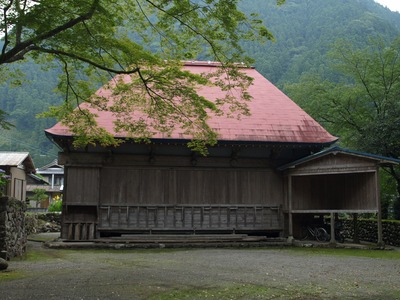文字サイズ
Tokushima Prefecture
Awa Rural Community Theaters are said to have started being built at the end of late Edo Period (mid-19th century).
Festivals to wish or give thanks for a good harvest used to be held at village shrines and farmers presented performance arts such as songs and dances in addition to other offerings.
The performance arts developed from Bon festival dance (dance to welcome the sprits of the dead) to puppet shows. Farmers then built a theater to practice handling puppets in the precincts of the shrine, the common land of their village.
Awa Rural Community Theater features a puppet show with Tayuza where Joruri (traditional Japanese narrative music) narrators sit, and boasts the largest number of existing Rural Community Theaters in Japan.

The theater built in 1873 is valuable as its structure still remains almost in its original form as when it was used for performances. (Designated Tangible Cultural Property by Tokushima City, October 17, 1978) It was also designated as National Important Tangible Folk Cultural Property in 2008. Its mechanical system handles 132 papered sliding doors and 42 stage backgrounds. There is a building for the mechanical system, Okusenjyo at the center-back of the stage, and enables the creation of Senjojiki—the backgrounds using the laws of perspective. There is also a dressing room under the mechanical system like the bottom of a ship, dug under the ground to use the space effectively. This is valuable and the only one existing in Tokushima.

Approximately 1,500 papered sliding doors with pictures drawn between late Edo Period and Taisho Period (late 18th century–early 20th century) still remain in Kamiyama-cho. Interesting pictures of the sliding doors include “Senjojiki (outdoor scenery)”, “bamboo and tiger”, “dragon and god of thunder”, “pine tree, crane and morning sun”, etc. and they are preserved and placed in wooden boxes in Ono Sakurano Theater. The mechanical system is set on the ceiling and it looks as if it was used for sliding door tricks such as Dengaku-gaesi (turning the sliding doors).

The theater was restored in 2006 in the form of approximately 70 years ago when Japanese Joruri puppet plays took place. It has a “temporary Funazoko-butai” (stage lower than the theatre stage for puppeteers) that is rare in Japan. Normally the stage is flat with 7.2-meter width and 5.4-meter depth, and changes into Funazoko-butai, creating a step when puppet plays take place. Some parts such as cedar floorboards and sleepers are removed from the flat stage to set up Funazoko-butai

The theatre is located on the right-hand side of the shrine as you face it, with three latticed shutters and Tayuza. Before the restoration, the material of the beams used to be from the Edo Period (1603–1868) and the building was built in the Meiji Period (1868–1912). Due to aging, the theatre was demolished and rebuilt in the same form with latticed shutters and Tayuza but slightly larger in size in March 1991.

It is located in the precincts of Shirahito Shrine surrounded by a clear stream and large trees. Once it used to be on the right-hand side of the shrine building as you face it, but it was rebuilt on the left-hand side having the river at the back in early Meiji Period (late 19th century). The reason why it was relocated is because the noise of the river disturbed the narrators’ voice. “Haigyu Ningyo-za” (puppet troupe) with 40 puppet heads—some are made by Tenguhisa and Ningyochu (puppet makers)—used play. The first revival play in 50 years was performed in 2004.

The theater is located in the precincts of Tsubute Shrine. The site was built in 1896 for stage equipment for puppets, and a hall of worship, shrine and theater are located there. The theater has valuable Tayuza, Senjojiki equipment and sliding doors. The stage and sliding doors are designated as Tangible Cultural Property by the town. The sliding doors are stored by hanging in its own storage so that the inside is not humid. Therefore, the pictures drawn on the sliding doors—said to be drawn in the middle of Meiji Period (late 19th century)—are not faded at all.

The theater was rebuilt in 1898 and its architectural style is one of the rarest in the whole country. Traditional puppet play is performed on the last Sunday of October and November 22 (the fall festival) each year. (Designated Tangible Folk Cultural Property by Tokushima Prefecture, August 30, 1974)

The rural community theater located in Kito, Naka-cho near the border between Kochi Prefecture and Tokushima Prefecture. Although it is located deep in the mountains and a two-hour journey by car from Tokushima City, the records of the programs performed by a puppet troupe from Awaji in late Edo Period (late 18th century–early 19th century) are found on the theater wall, recalling the olden time.

The building demonstrates villagers’ affection towards the rural community theater at that time as it has plenty of large-sized timbers and hip-and a gable style tiled roof decorated with a dragon sculpture. It is usually used as a hall of worship
It has a “temporary Funazoko-butai” system (stage lower than the theatre stage for puppeteers) which is rare in Japan. Its flat stage transforms into Funazoko-butai for Joruri puppet shows by sliding removable panel-like floor boards under the floor.

Copyright © Tokushima Prefecture, All rights reserved.